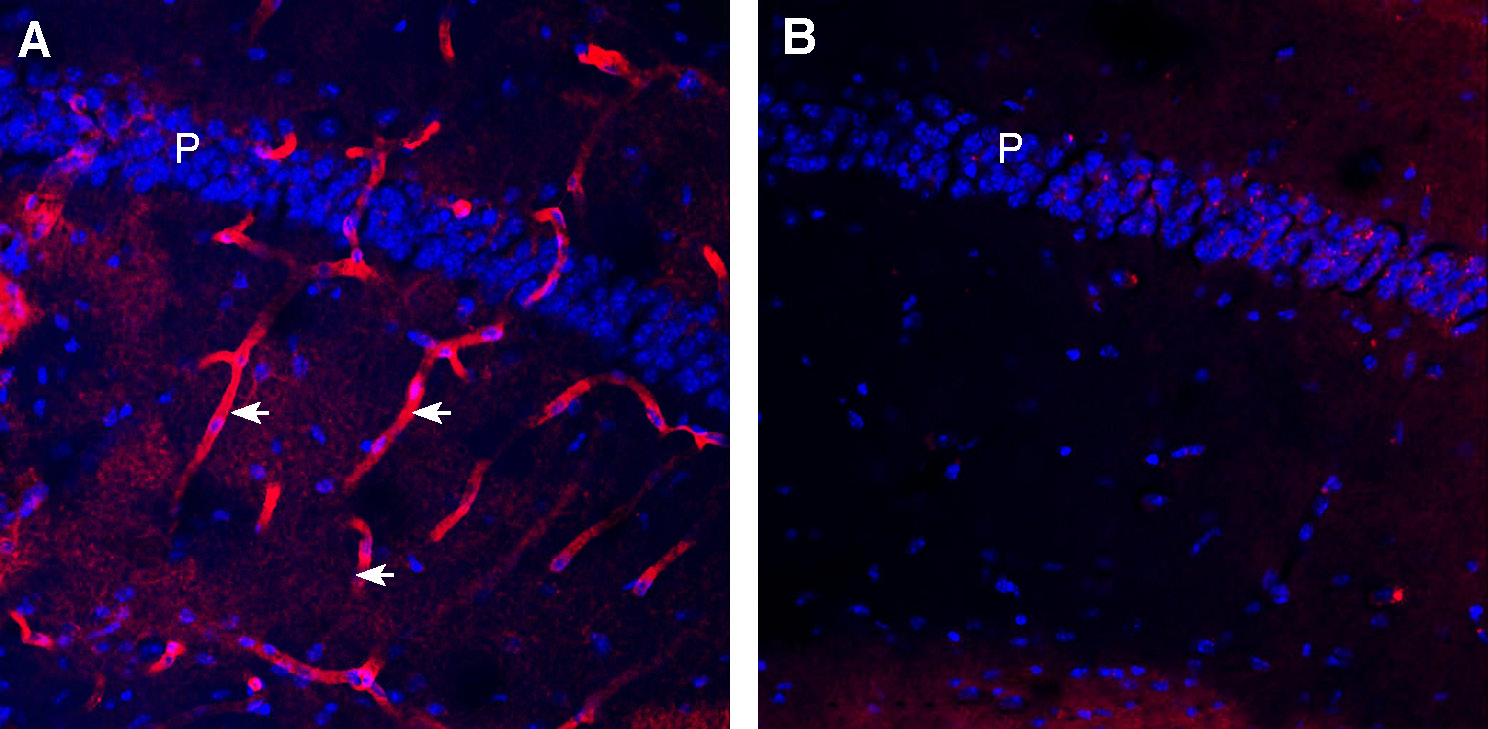Overview
- Peptide (C)HVIDIDRGDEKKGKD, corresponding to amino acid residues 300-314 of rat AQP4 (Accession P47863). Intracellular, C-terminus.

Aquaporin 4/AQP4 (300-314) Blocking Peptide (BLP-QP014)
 Western blot analysis of rat brain membranes (lanes 1 and 3) and mouse brain membranes (lanes 2 and 4):1, 2. Guinea Pig Anti-Aquaporin 4 (AQP4) (300-314) Antibody (#AQP-014-GP), (1:400).
Western blot analysis of rat brain membranes (lanes 1 and 3) and mouse brain membranes (lanes 2 and 4):1, 2. Guinea Pig Anti-Aquaporin 4 (AQP4) (300-314) Antibody (#AQP-014-GP), (1:400).
3, 4. Guinea Pig Anti-Aquaporin 4 (AQP4) (300-314) Antibody, preincubated with Aquaporin 4 (AQP4) (300-314) Blocking Peptide (#BLP-QP014).
 Expression of Aquaporin 4 in mouse hippocampus.Immunohistochemical staining of perfusion-fixed frozen mouse brain sections with Guinea Pig Anti-Aquaporin 4 (AQP4) (300-314) Antibody (#AQP-014-GP), (1:200), followed by goat anti-guinea pig - Alexa Fluor-594. A. Staining in the hippocampal CA1 region, showed immunoreactivity (red) in blood vessel outlines (arrows). B. Pre-incubation of the antibody with Aquaporin 4 (AQP4) (300-314) Blocking Peptide (#BLP-QP014), suppressed staining. Cell nuclei are stained with DAPI (blue). P = pyramidal layer.
Expression of Aquaporin 4 in mouse hippocampus.Immunohistochemical staining of perfusion-fixed frozen mouse brain sections with Guinea Pig Anti-Aquaporin 4 (AQP4) (300-314) Antibody (#AQP-014-GP), (1:200), followed by goat anti-guinea pig - Alexa Fluor-594. A. Staining in the hippocampal CA1 region, showed immunoreactivity (red) in blood vessel outlines (arrows). B. Pre-incubation of the antibody with Aquaporin 4 (AQP4) (300-314) Blocking Peptide (#BLP-QP014), suppressed staining. Cell nuclei are stained with DAPI (blue). P = pyramidal layer. Expression of Aquaporin 4 in rat subfornical organ (SFO).Immunohistochemical staining of perfusion-fixed frozen rat brain sections with Guinea Pig Anti-Aquaporin 4 (AQP4) (300-314) Antibody (#AQP-014-GP), (1:200), followed by goat anti-guinea pig - Alexa Fluor-594. A. Aquaporin 4 immunoreactivity (red) appears in blood vessel outlines (arrows). B. Pre-incubation of the antibody with Aquaporin 4 (AQP4) (300-314) Blocking Peptide (#BLP-QP014), suppressed staining. Cell nuclei are stained with DAPI (blue). SFO = subfornical organ.
Expression of Aquaporin 4 in rat subfornical organ (SFO).Immunohistochemical staining of perfusion-fixed frozen rat brain sections with Guinea Pig Anti-Aquaporin 4 (AQP4) (300-314) Antibody (#AQP-014-GP), (1:200), followed by goat anti-guinea pig - Alexa Fluor-594. A. Aquaporin 4 immunoreactivity (red) appears in blood vessel outlines (arrows). B. Pre-incubation of the antibody with Aquaporin 4 (AQP4) (300-314) Blocking Peptide (#BLP-QP014), suppressed staining. Cell nuclei are stained with DAPI (blue). SFO = subfornical organ. Multiplex staining of MERTK and Aquaporin 4 in rat parietal cortex.Immunohistochemical staining of perfusion-fixed frozen rat brain sections with Anti-MERTK (extracellular) Antibody (#ATR-033), (1:300), followed by goat anti-rabbit-AlexaFluor-488 and Guinea Pig Anti-Aquaporin 4 (AQP4) (300-314) Antibody (#AQP-014-GP), (1:300), followed by goat anti-guinea pig-AlexaFluor-594. A. MERTK immunoreactivity (greens) appears around blood vessels (arrows). B. Aquaporin 4 immunoreactivity (red) appears around blood vessels (arrows). C. Merge of the two images reveals several vessels that express both MERTK and AQP4 (arrows point at examples).
Multiplex staining of MERTK and Aquaporin 4 in rat parietal cortex.Immunohistochemical staining of perfusion-fixed frozen rat brain sections with Anti-MERTK (extracellular) Antibody (#ATR-033), (1:300), followed by goat anti-rabbit-AlexaFluor-488 and Guinea Pig Anti-Aquaporin 4 (AQP4) (300-314) Antibody (#AQP-014-GP), (1:300), followed by goat anti-guinea pig-AlexaFluor-594. A. MERTK immunoreactivity (greens) appears around blood vessels (arrows). B. Aquaporin 4 immunoreactivity (red) appears around blood vessels (arrows). C. Merge of the two images reveals several vessels that express both MERTK and AQP4 (arrows point at examples).
- King, L.S. et al. (2004) Nat. Rev. Mol. Cell Biol. 5, 687.
- Manley, G.T. et al. (2004) Neuroscience. 129, 983.
- Lennon, V.A. et al. (2005) J. Exp. Med. 202, 473.
Aquaporin 4 (AQP-4) belongs to a family of membrane proteins that allow passage of water and certain solutes through biological membranes. The family is composed of 13 members (AQP-0 to AQP-12).
The aquaporins can be divided into two functional groups based on their permeability characteristics: the aquaporins that are only permeated by water and the aquaglyceroporins that are permeated by water and other small solutes such as glycerol. AQP-4 together with AQP-1, AQP-2 and AQP-5 belong to the first group1. Little is known about the function of the two newest members, AQP-11 and AQP-12.
The proteins present a conserved structure of six transmembrane domains with intracellular N- and C-termini. The functional channel is a tetramer but each subunit has a separate pore and therefore the functional channel unit, contains four pores1.
AQP-4 is the major membrane water channel in the central nervous system. The channel is expressed in astrocyte foot processes in direct contact with capillary vessels in the brain suggesting a role in water transport under normal and pathological conditions. Indeed, transgenic mice lacking AQP-4 have reduced brain swelling and improved neurological outcome following water intoxication and focal cerebral ischemia. In contrast, brain swelling and clinical outcome are worse in AQP-4-null mice in models of vasogenic (fluid leak) edema caused by freeze-injury and brain tumor, probably due to impaired AQP-4-dependent brain water clearance2.
In addition, it has been recently shown that neuromyelitis optica (NMO), an inflammatory demyelinating disease that selectively affects optic nerves and spinal cord, is caused by the development of an autoantibody directed against AQP-43.
Application key:
Species reactivity key:
Guinea Pig Anti-Aquaporin 4 (AQP4) (300-314) Antibody (#AQP-014-GP) is a highly specific antibody directed against an epitope of the rat protein. The antibody can be used in western blot and immunohistochemistry applications. It has been designed to recognize Aquaporin 4 from mouse, rat and human samples.
The antigen used to immunize guinea pigs is the same as Anti-Aquaporin 4 (AQP4) (300-314) (#AQP-014) raised in rabbit. Our line of guinea pig antibodies enables more flexibility with our products such as multiplex staining studies, immunoprecipitation and more.
